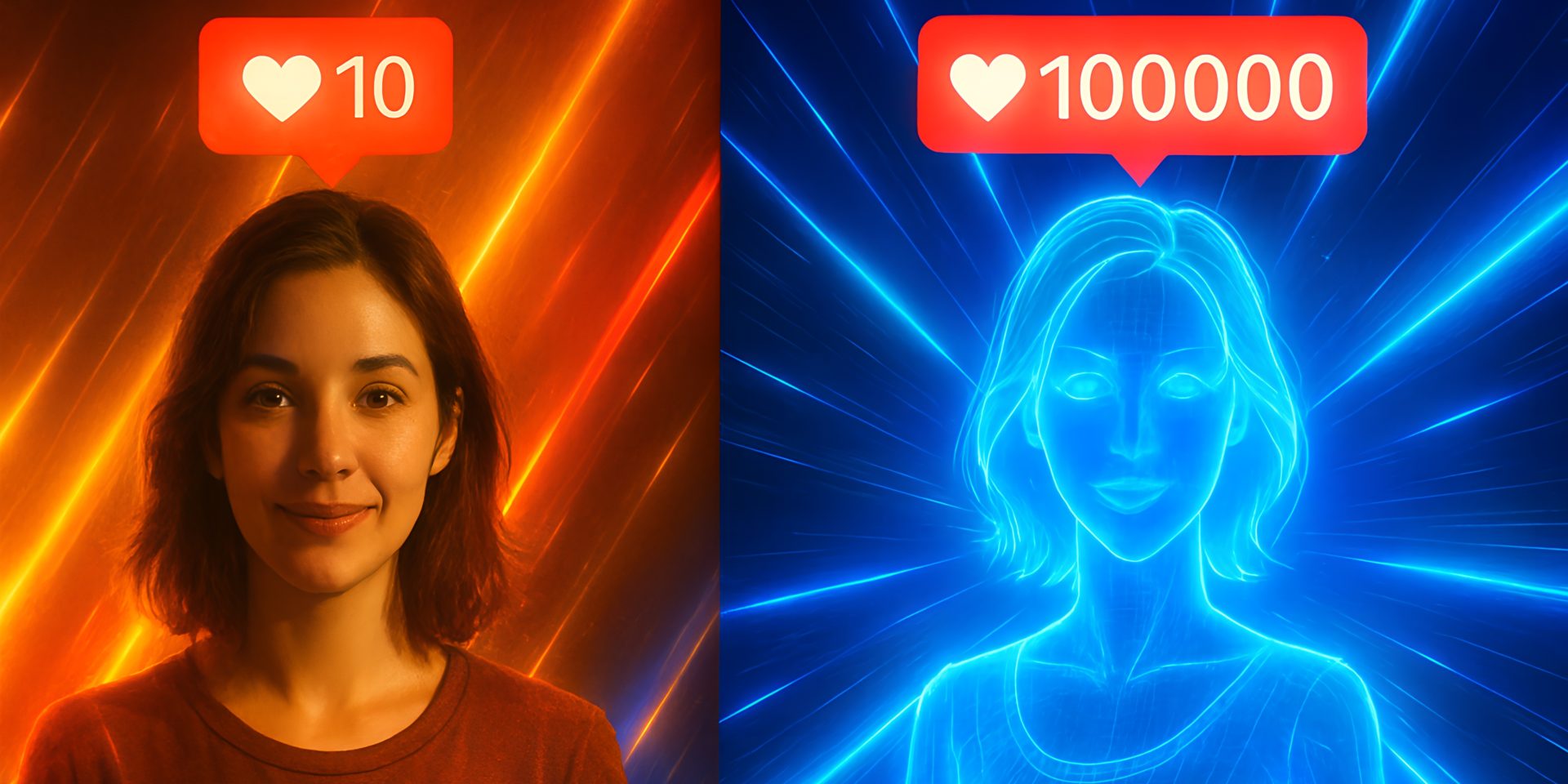The influencer marketing industry has undergone a significant transformation, with 48.7% of individuals embracing artificial intelligence (AI).
The development of AI is not an enigmatic future; it is here now and transforming industries in ways that were unimaginable a few decades ago. Marketing is one of the sectors undergoing rapid transformation. There is no clear distinction between human influencers and online influencers in this context. In a time where virtual influencers can be as powerful as human influencers, how can authenticity endure? Marketers, brands, and consumers all ask this same question: how can authenticity survive? In this blog, we will see how Influencer Marketing Evolution: Micro and Nano-Influencers vs AI-Generated Virtual Influencers.
The Rise of AI-Driven Influencers
Imagine you’re scrolling through Instagram and pondering if the user you’re following is real or created by artificial intelligence. Influencers with virtual identities are rapidly growing in importance within the business, giving businesses new possibilities while also creating grave concerns. While AI profiles could boost the effectiveness of marketing, they can also undermine the fundamental principles of trust and reliability when it comes to marketing. Are you aware of how to discern between genuine and what’s real?
What Are Micro and Nano Influencers?
- Micro-influencers are typically between 10,000-100,000 followers.
They provide highly engaged, small-scale audiences that have greater confidence and credibility.
- Nano-Influencers: Creators who are smaller and have 1000 to 10,000 followers are typically considered to be highly relatable and admired by their tight-knit communities.
Why Micro and Nano Influencers Matter in 2025
- Higher Engagement Rates A smaller audience usually leads to more relationships and greater interactions.
- Cost-Effective: It is easier for brands with modest budgets to collaborate with multiple nano/micro-influencers than with big celebrities.
- Specific Niches: The perfect tool for reaching certain populations or groups of interest.
- Authenticity: Their web pages feel less scripted, which increases the brand’s credibility.
The Challenges for Influencer Marketing 2025.
While influencer marketing is changing, however, there are challenges to be faced. These are the things that brands and digital marketing services must be aware of:
AI-generated deepfake influencers.
- It is not all AI influencers are reputable. Deepfake technology is gaining popularity. This can mean that brands create influencers that resemble real people without consent. The issue of ethics and legal issues.
Over-saturation & consumer fatigue.
- Everybody is trying to become an influencer; people are getting a bit naive to influencer marketing. An analysis of Socialbakers revealed that 72% of the population believes that influencers will be “too commercial” in 2025.
- Solution: Brands must be more focused on creating stories, not selling. Instead of merely pushing their items, nano and micro-influencers are expected to entertain, inform, or motivate their followers.
Fake followers & engagement fraud.
- False followers remain an issue. Micro and nano-influencers can purchase engagements in order to look more influential than they are.
- Solutions: Businesses should use AI-powered tools such as HypeAuditor or Upfluence to identify fraudulent engagement prior to deciding to invest in an influencer.
Why use influencer marketing?
Influencer marketing is an incredible marketing technique for your business, and many brands have already used the technique to their advantage, as these examples of influencer marketing demonstrate.
According to the 2024 Influencer Marketing Report, more than fifty percent of people (49 percent) buy every month at least through posts by influencers. It’s not surprising that the industry of influencer marketing will likely hit an all-time high in the amount of U.S. $33 billion in 2025, as per Statista.
There are more reasons to add influential people to your marketing strategy.
Greater brand recognition
Working with an influencer can bring more people to your company. When your company is featured within their posts, it introduces the brand to new viewers who might not be aware of the brand. The trust that the influencers have with their fans improves the reputation of your company and trustworthiness, which increases the visibility of your brand in the market.
Precise audience targeting
Influencer marketing aids brands in achieving specific audience targeting by connecting companies to influencers with followers who are in line with the audience. It ensures that their message is delivered to the correct audience and conveys a message that is a match for the target people who are following the campaign, making it more efficient.
Conversions higher
Social proof plays a major aspect in the possibility of purchasing a product or service following an influencer’s campaign, as it assists in influencing consumers who aren’t sure about your cause. In addition, influencers frequently share activities that are interactive, like competitions, contests, or live-streamed sessions, which encourage participation and trigger actions, such as orders or signing up for offers. They may also offer exclusive discounts or offers that make it easier to track results directly related to their promotions.
Establishing credibility and trust with your target audience
Influencers establish trust with their fans by providing personal stories and experiences that are a hit with their fans, which makes them more likable. They also increase their authority by revealing their partnership with brands and only promote brands they truly believe in.
Additionally, their free scripts contrast with conventional commercials and sound natural and spontaneous. This helps build a sense of personal trust with the viewers. Trust is also bolstered through their responses to messages and makes their followers feel respected and appreciated, thus enhancing the connection. This all aids influencers in driving a higher rate of conversion for brands.
How can you monitor the influencer marketing campaign of a marketer?
There are several methods to gauge the effectiveness of your advertising campaign.
In this case, you could utilize native analytics within your social media platforms to monitor the impact of the posts you have created by your influencers. If you pair them with campaign tags or other components like hashtags, like #SproutPartner, for example, you’ll be able to monitor the posts your influencers make and engage with.
To fully comprehend the effect of your influencer marketing campaigns, the use of an influencer marketing platform such as Sprout with robust analytics is crucial. With Sprout’s Influencer Marketing, You can easily evaluate and track the impact of your marketing through influencers in conjunction with other organic social networks.
Comprehensive metrics and reports let you:
- The report summarizes the performance of your campaign: Automate the filling of information about campaign performance to create an overall report that is editable to gain more understanding.
- Make reports to meet your requirements: You can gain access to a library of template reports or begin with a blank slate and create your custom report.
- Tracking links helps comprehend the impact of campaigns: Use affiliate links that have UTMs and pixels so you can monitor campaign contents via conversion.
- Collect business data to inform choices: Monitor your intended audience across different platforms, learn about how they interact across platforms, and gather important insights that will help you optimize your influencer strategy and social strategy.
If your strategy for the influencer market is getting underway, the correct platform will help in the execution and monitoring. Our comprehensive buyer’s guide will assist you in choosing the most effective influencer marketing platform that can execute your marketing campaigns.
Conclusion
The market for influencers by 2025 will be more vibrant and varied than ever. Micro, nano, and AI-driven influencers all have distinctive advantages for brands to use to create authentic interaction, creative storytelling as well as measurable return on investment.
The adoption of this technology will allow marketers to stay ahead in establishing meaningful connections with customers in a rapidly changing digital age.






